Can You Use Spackle On Wood
Trying to decide between spackle vs caulk and wood filler vs caulk for filling holes and gaps in your DIY projects? This beginner's guide walks you through caulk, wood filler, woods putty, spackle, and articulation chemical compound. Larn how to choose the right product with conviction!
Thank yous to DAP for sponsoring this guide on caulk, wood filler, and spackle! All opinions are entirely my own. This post besides contains affiliate links, but zip that I wouldn't recommend wholeheartedly. Read my full disclosure here.
There are and so many unlike kinds of materials to fill holes and gaps in your DIY projects and around your house. Caulk, forest filler, wood putty, spackle, articulation chemical compound…just to name a few.
It's no wonder that virtually DIYers and homeowners are pretty confused near what the best product is.
Whether you lot are filling gaps in trim and baseboards or filling nail holes, there are a lot of last finishing touches needed when you're working on weekend DIY home projects, renovations, and woodworking projects.
Caulk Overview
Caulk or caulking is a cloth used to fill gaps in the seams between two materials or to seal joints. It is sold in a tube that is loaded into a caulking gun, which is used to push out the caulking into the seam. Information technology is also sold in a squeeze tube.
Caulk is used both to make seams, joints, and corners sealed off from water, bugs, air, and/or h2o.
Caulk is usually fabricated of either latex or silicone (or a combination of the two).
At that place are tons of different types of caulk for all sorts of renovation and construction uses, so it's very important that you're choosing the right caulk for the job.
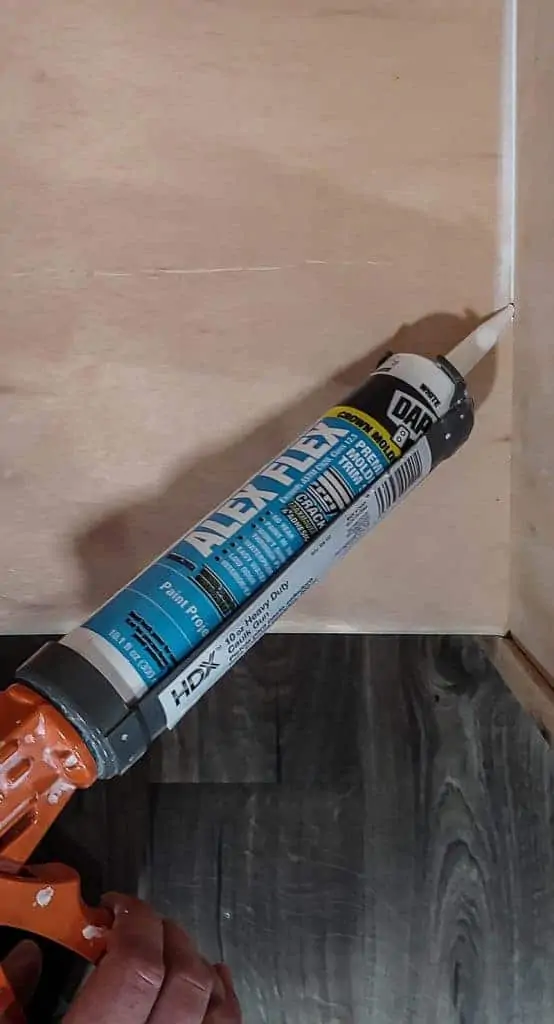
What is caulk used for?
- Flexible outside caulk is used around windows, doors, siding, and around the trim
- Flexible interior caulk is used effectually trim and baseboards, on the corners and edges of accent walls (like shiplap)
- Interior caulk for kitchens and bathrooms (or anywhere that may go wet or exposed to moisture) is used for all joints, corners, and gaps betwixt ii materials. For case, where sinks encounter countertops, where tile meets countertops on backsplashes, where a bathtub or shower meets the wall or floor, etc.
Acquire more than well-nigh the different caulk types and how to utilise them!
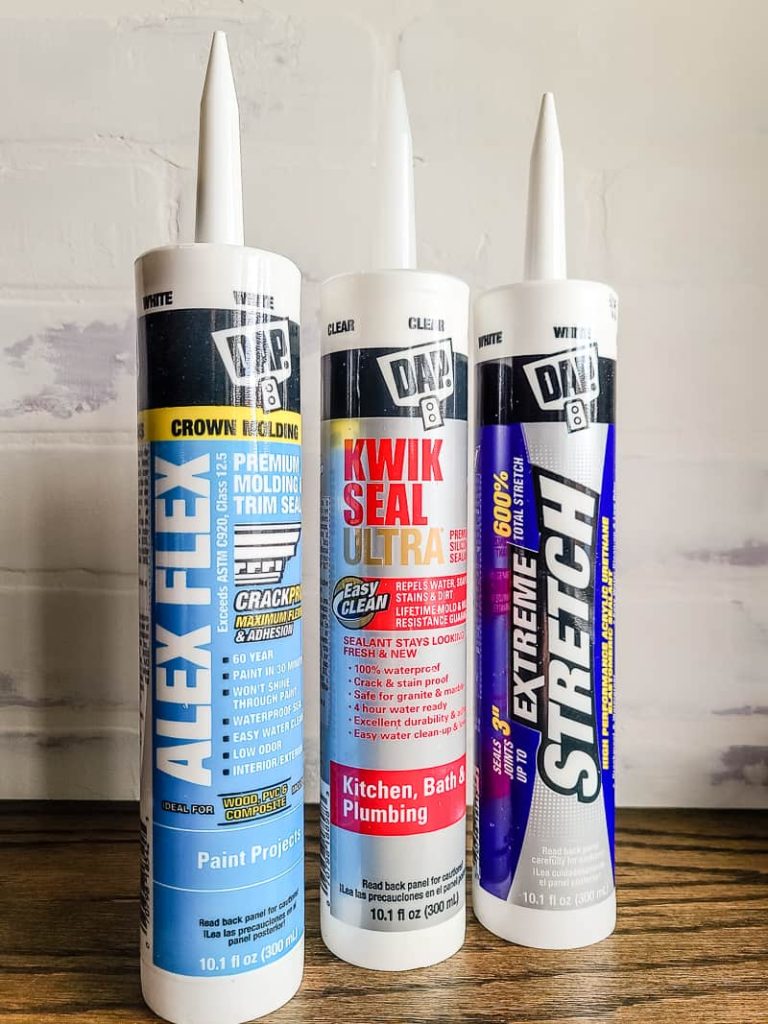
What's the best caulk?
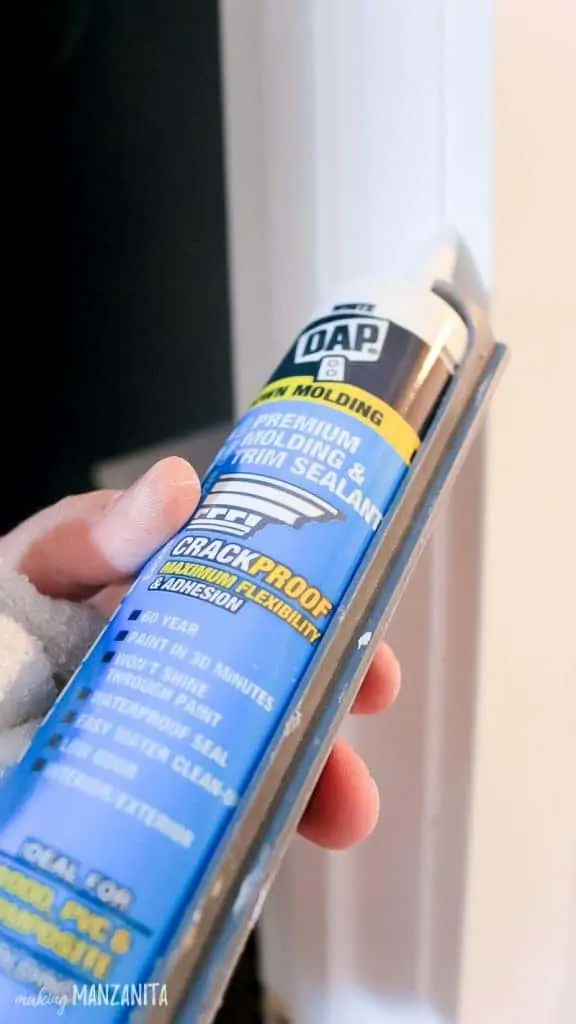
Alex Flex Caulk
For interior applications for trim and molding, we beloved DAP's Alex Flex Premium Molding & Trim Acrylic Latex Siliconized Sealant. It is a high-operation sealant specifically formulated for use in molding and trim applications. It delivers excellent adhesion and flexibility for a crack-proof seal. We as well dear that it is ready to paint within thirty minutes.
Farthermost Stretch Caulk
If the caulking is needed in an area that will undergo an extreme change in temperature or possible movement, another smashing option is DAP'south Extreme Stretch Acrylic Urethane Premium Elastomeric Sealant. It is a high-quality caulk that is platonic for sealing a wide variety of interior & outside surfaces. It is particularly formulated to stretch over 600% ensuring the seal does not crack or lose adhesion making it perfect for most sealing projects including windows, doors, trim, siding, corner joints, sinks, and countertops.
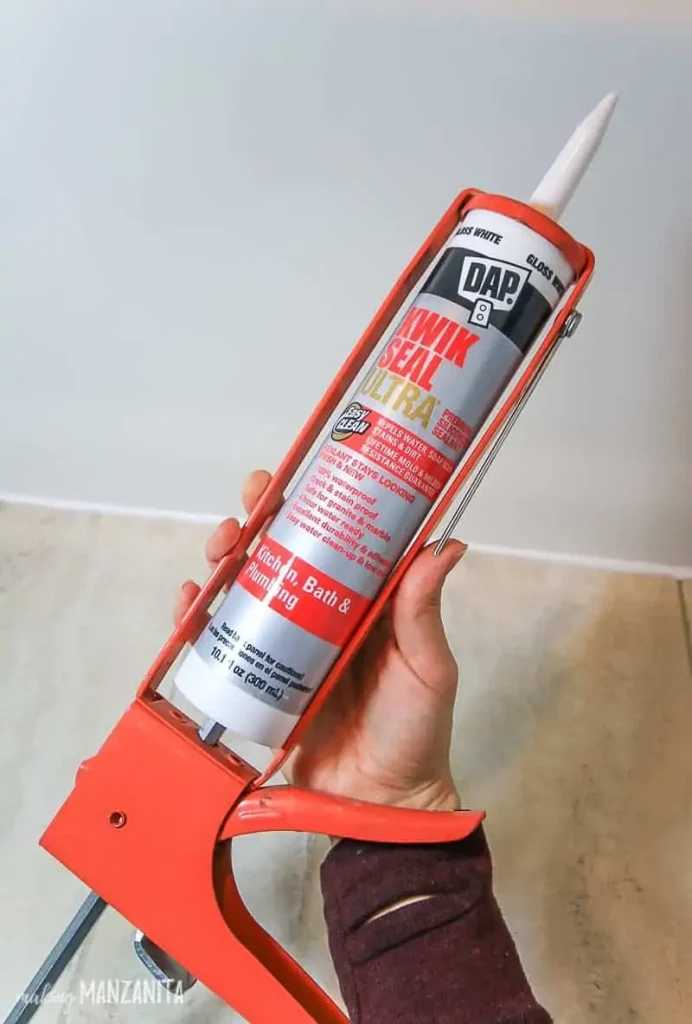
Kwik Seal Ultra Caulk
For sealing in the kitchen and bathrooms, we dearest DAP'south Kwik Seal Ultra Advanced Kitchen & Bath Sealant. It is an advanced sealant formulated with innovative ultra-hydrophobic engineering science that repels water, dirt, and stains and offers a lifetime mold and mildew resistance guarantee and then the sealant stays looking make clean, fresh, and new.
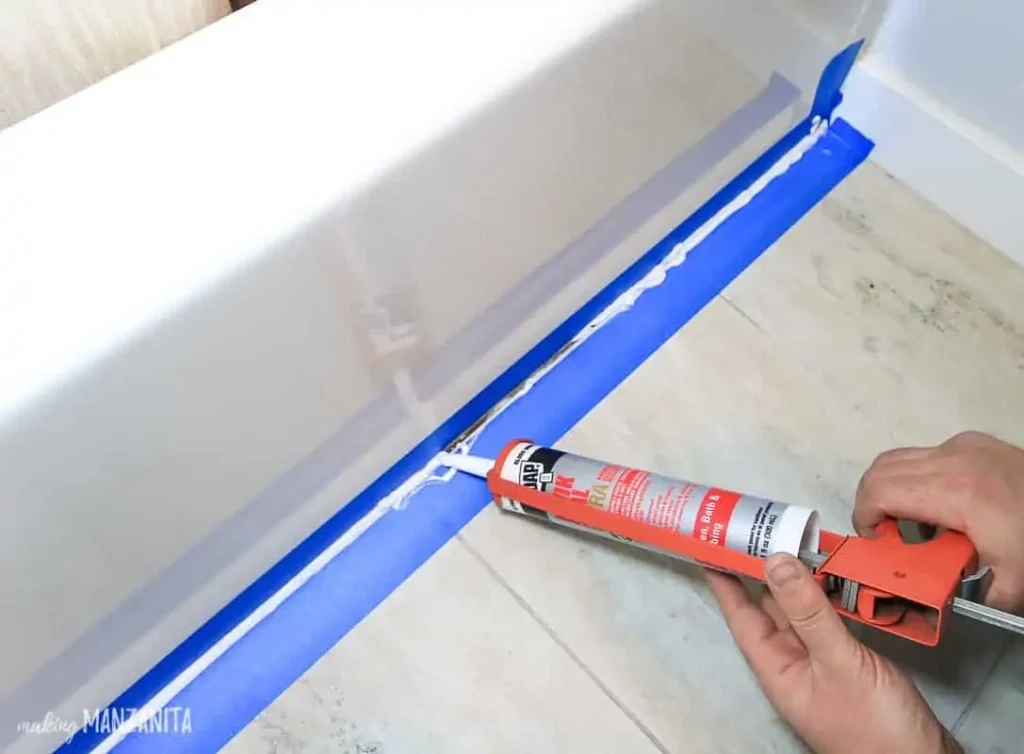
Can you lot use caulk to fill nail holes?
When you're handling things like trim, you'll come beyond both smash holes and gaps between the trim and wall. Chances are that you'll exist tempted to merely fill nail holes with caulk while y'all have it out. Why non hit two birds with one stone, correct?
We exercise not recommend using caulk to fill boom holes.
The downside of using caulk to fill nail holes is that caulk is not sandable, so you lot tin get it as smoothen as forest filler or spackle. Caulk is also adequately messy, and then it'south a risk to use caulk to fill a pocket-sized nail hole.
Lastly, caulk is more likely to shrink over time rather than wood filler or spackle.
Woods Filler Overview
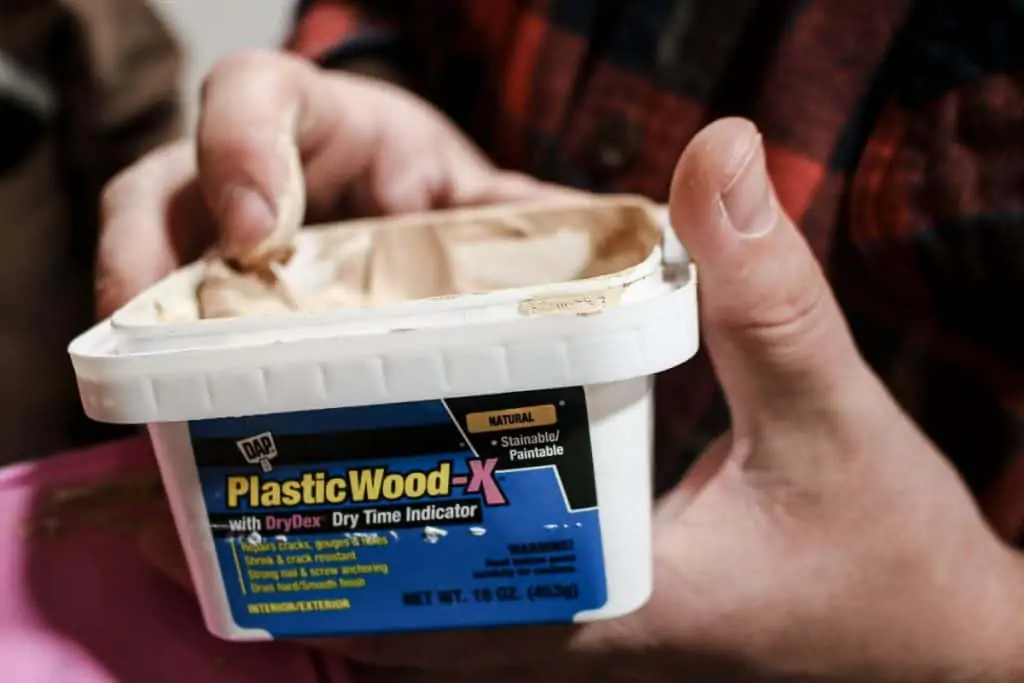
Wood filler is a sandable fabric that can exist applied to nail holes, gouges, cracks, gaps, and imperfections on the wood surface.
Typically wood filler is used once a project is built, but not yet stained/painted/sealed. Filling boom holes and other imperfections is i of the final steps in your woodworking projects.
One time applied and dried, y'all can sand it shine and stain or paint your projection.
What is wood filler used for?
- Filling nail holes in woodworking projects
- Filling gouges and imperfections in the wood
- Filling dents, gouges, and nail holes in wood trim and baseboards (that has not been stained or sealed yet)
- Smoothing cracks in wood projects
- Smoothing joints (where two pieces of forest come up together)
- Shape damaged areas, like corners and edges
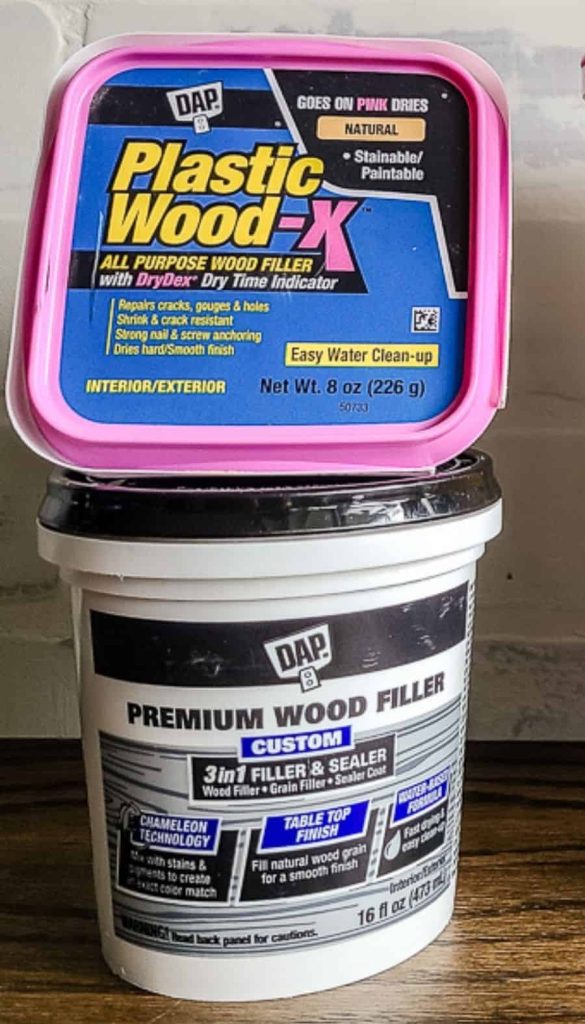
What is the all-time wood filler?
Plastic Woods X All Purpose Woods Filler
For filling nail holes, gouges, cracks, and imperfections in the woodworking projects we typically use DAP's Plastic Forest 10™ All Purpose Wood Filler with DryDex Dry out Time Indicator.
One affair I honey nearly it is that information technology goes on pink and dries to a natural, wood finish, then you know when it's set up to sand! How cool is that? This patented applied science eliminates the guesswork of trying to figure out when to sand and reduces the chance of errors.
The forest filler is prepare-to-utilise and has a thick knife-class formula that spreads easily for fast, professional repairs and can even be practical on vertical surfaces.
Plastic Woods X is stainable, paintable, and won't compress crack, or crumble. Information technology can be sanded, planed, cutting, drilled, screwed, or nailed once cured.
Premium Woods Filler
DAP's Premium Forest Filler is a custom 3-in-1 wood filler, grain filler, and sealer coat. It has a unique water-based formula that allows you to more accurately match existing wood tones to create a repair that is seamless and invisible.
The Premium Wood Filler won't sink, shrink, fissure or fall out. Information technology has stiff touch on resistance making it perfect for edge or cleft filling. It dries fast (a little faster than Plastic Forest 10), which allows you to finish your woodworking project faster.
The Premium Woods Filler has Chameleon Color Blend Technology allows you lot to mix stains or pigments directly into the wet state for an verbal colour match. Alternatively, you can as well employ the stain later on considering this wood filler accepts stains, tints, pigments, dyes, and finishes.
If you desire to use it equally a grain filler (similar if you're painting the wood surface and don't want to exist able to meet the forest grain texture through the paint) y'all tin sparse it slightly with warm h2o until you lot become to a thick paint-like consistency. And so brush information technology across the wood grain to fill the natural wood pores. This will provide a smooth, tabletop finish.
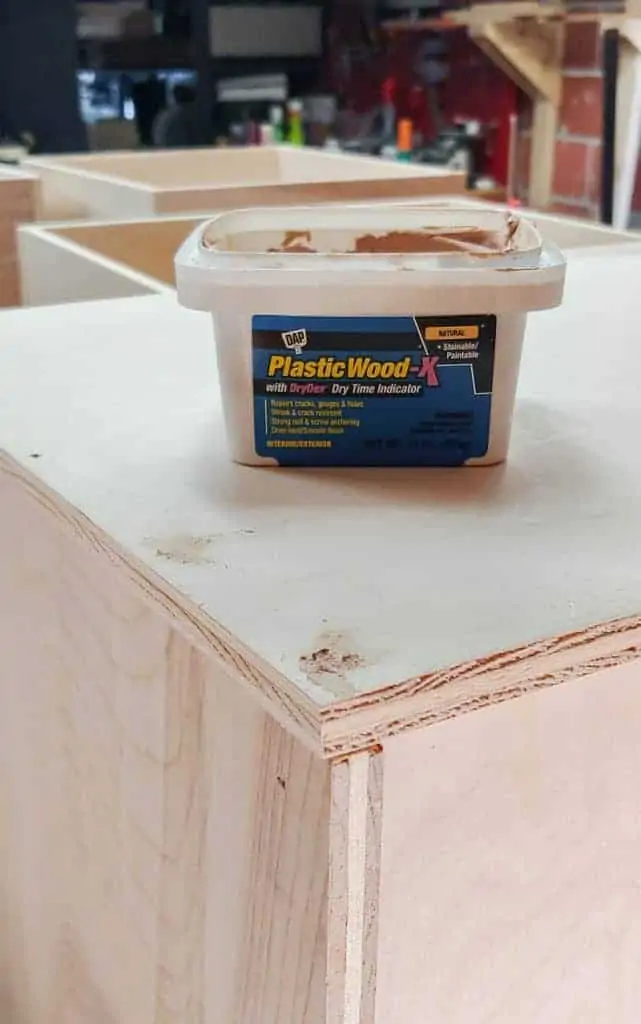
How to apply wood filler
- Clean the surface. The area that needs filling should exist clean – dry out and free of dirt and sanding grit. The surface and air need to be in a higher place 40 degrees F.
- Apply forest filler. Use a make clean putty knife to push forest filler into larger gouges and lightly scrape the knife flat over the surface to smooth out. For small boom holes, you can only use your finger to printing the filler into the hole. You lot desire to overfill the repair slightly when applying the wood filler so you can sand it downwards to a smooth, flat finish once dry.
- If the damaged area is deeper than 1/8″ – 1/4″, employ the woods filler in layers and let each layer dry earlier moving on.
- Sand smooth. Once the wood filler is dried (when it is no longer pink if using Plastic Wood 10 with DryDex), you tin can sand smooth using 150 grit sandpaper. Information technology should take approximately 2-vi hours for shallow repairs to dry and up to 36 hours for deeper fills.
- Stain or pigment. Once sanded, typically you tin can stain or paint over the wood filler equally needed. Be sure to check the label for specific instructions so you tin can achieve the all-time finish possible.

Should I utilize wood filler or caulk?
To sum up the difference between caulk and wood filler, caulk is to be used to fill in corners and gaps between 2 materials, whereas wood filler should be used to make full blast holes and other impairment on flat wooden surfaces.
Forest filler tin be sanded and caulking tin can not.
Wood Putty Overview
Wood putty is a malleable cloth that is used to fill small holes and damage in woodworking and furniture. Wood putty is generally applied subsequently the project has been completed (significant stained, painted, and sealed).
Some other utilise of wood putty could be treating harm on older wooden furniture or molding. Even if the slice has been sealed for years, you can find a good colour match and fill the damage with wood putty.
Ane key feature of woods putty is that information technology does not harden once stale. Information technology remains malleable over time, meaning that you cannot sand information technology smooth.
Plastic Wood Putty (Not-Hardening)
DAP's Plastic Wood Putty is an easy-to-apply, not-hardening woods putty that is ideal for filling small holes and minor defects in interior wood surfaces (like stained baseboards) after assembly and finishing.
It is recommended for filling and hiding countersunk boom holes, gouges, scratches, and miter joints.
Plastic Woods Putty is available in 12 popular wood tones to match most finished forest surfaces. The colors can be blended together for custom colour matching.
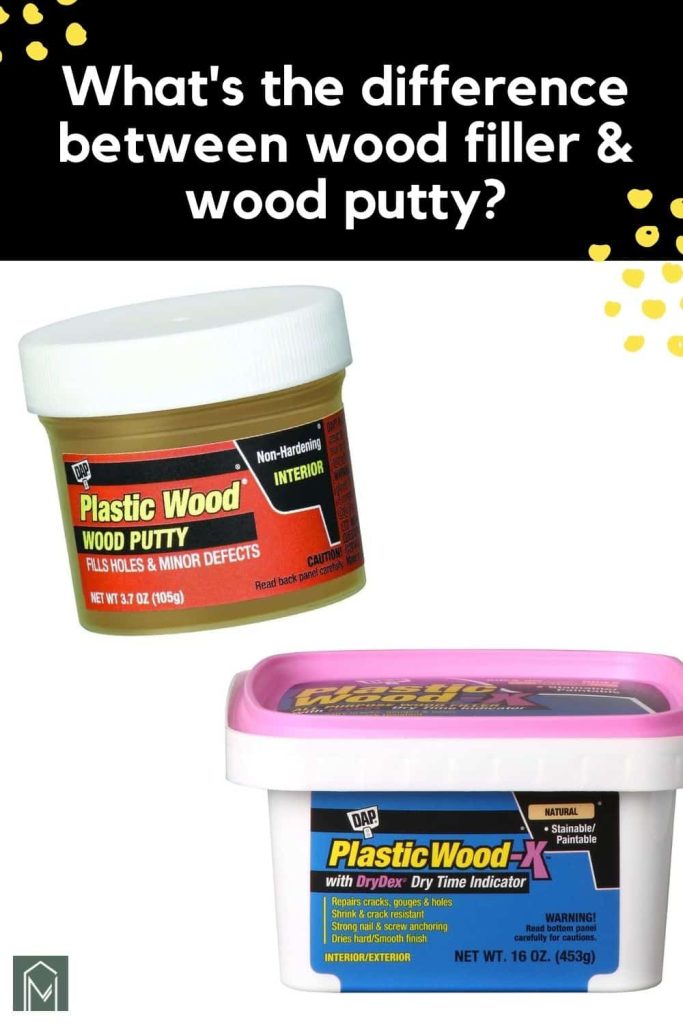
What is the difference between woods filler and wood putty?
The key difference between woods filler and forest putty is that forest filler hardens once dried (so it can be sanded shine) and forest putty does non.
Forest Filler can exist used on interior and exterior applications (at to the lowest degree the products I mentioned above), whereas forest putty tin be used on interior projects only.
Lastly, wood filler is meant to be used during the building procedure earlier the slice has been stained/sealed, or painted. On the other hand, forest putty is intended to exist practical subsequently the piece has been finished.
Spackle Overview
Spackle is a soft substance that is used to repair modest damaged areas in drywall (like pocket-size holes, dings, and dents) and make full nail holes on walls. Spackle is typically made from gypsum plaster, glue, and other compounds.
Spackle is definitely one of those must-haves for homeowners to always proceed around, specially if you're going to be doing any interior painting.
What is spackle used for?
- Filling boom holes on the wall before painting
- Smoothing dents and dings in walls before painting a room
- Filling dents, joints, and nail holes in pre-painted or primed trim and baseboards earlier painting
- Filling nail holes and any imperfections on a door frame or window trim (although check your characterization starting time considering some spackling is not made for door and window frames)
- Patching boom holes on accent walls, like board and batten and faux shiplap
- Repairing a pocket-size scissure in drywall
Spackle is used before painting a room to repair impairment to the walls, like boom holes and dents and dings.
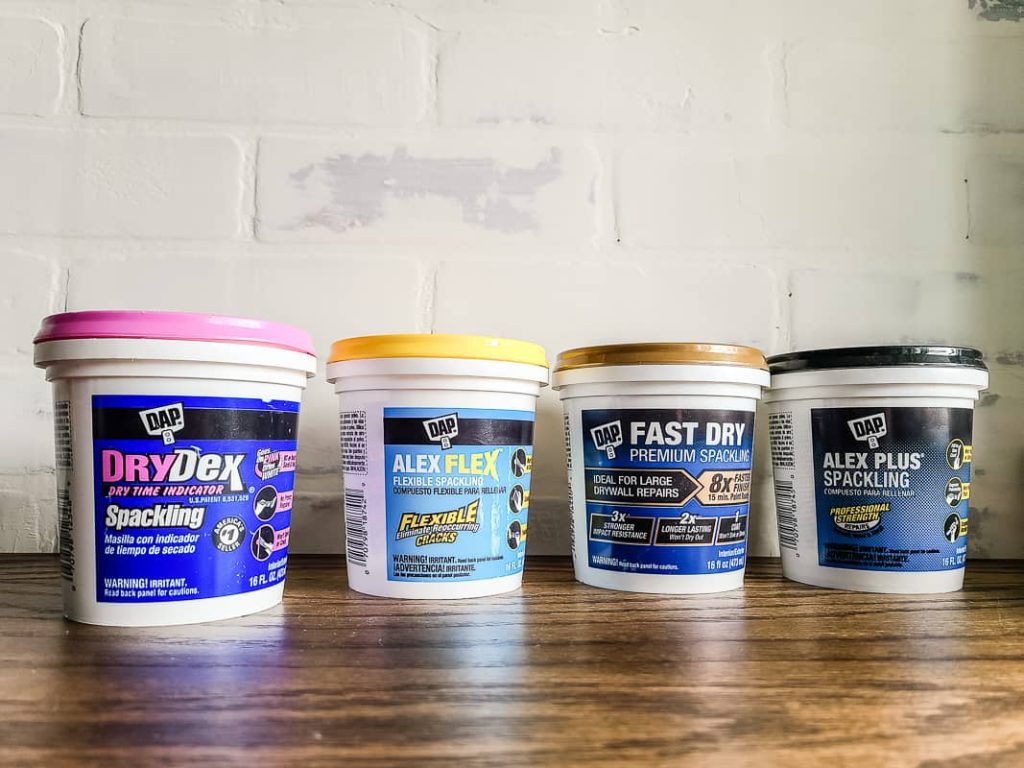
What is the all-time type of spackle?
DAP makes several dissimilar spackling products that fit different uses, jobs, and budgets. Here are 4 of our favorites!
DryDex Spackling
DAP's DryDex Spackling is America'south #1 seller and generally where we plough first when nosotros are filling holes before painting. DryDex Spackling shouldn't shrink or scissure after being applied.
Just like Plastic Wood X forest filler, it contains a patented DryDex Dry out Time Indicator causing the production to change colour when optimum dry time is achieved, which is by and large 1 to five hours. It goes on pinkish and turns white when dry! This unique feature is the indicator that it is gear up to sand and paint.
Alex Flex Flexible Spackle
If the area y'all're patching has a tendency to scissure and you've experienced reoccurring cracks in drywall, you should get with DAP's Alex Flex Flexible Spackling. It is like to DryDex spackle, in that it won't shrink or scissure and is sandable and paintable – but information technology is more flexible.
Fast Dry Premium Spackling
If you're in a hurry and don't desire to wait for one to five hours for the spackle to fully dry before sanding and painting, you lot can use DAP's Fast Dry Premium Spackling. Information technology has an 8x faster dry out time when compared to traditional heavyweight spackling and is usually prepare to paint in just 15 minutes.
Alex Plus Spackling
DAP's Alex Plus Spackling is another not bad option for filling holes & cracks in surfaces such as drywall, plaster, wood, brick, metal, and stone. It has a ready-to-use, smoothen white formula that spreads easily for fast, professional repairs that will not sink, compress or crack.
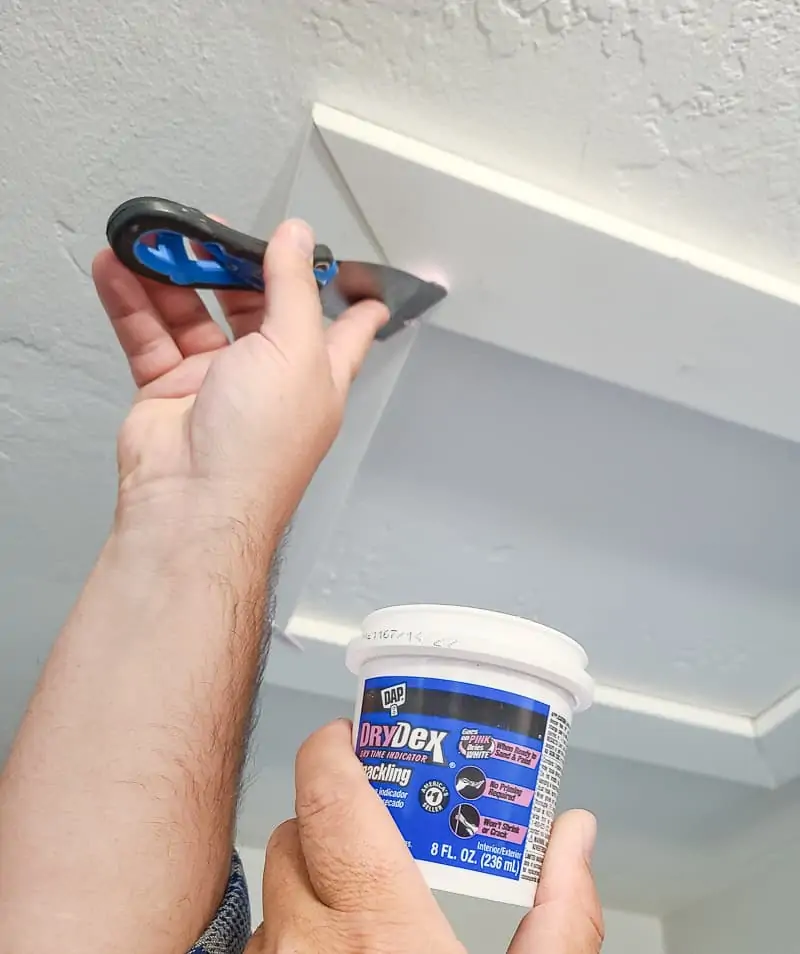
How do you use spackle?
- Clean the surface. The area that needs patching should be make clean – dry out and free of dirt and dust. If yous need to larn more than virtually how to clean walls before painting, bank check out this tutorial.
- Employ spackle. Stir up spackle using a putty knife. Apply a clean putty knife to push spackle into holes and damaged areas, and so lightly scrape the knife flat over the surface to smooth out. For small smash holes, you can simply utilise your finger to press the spackle into the pigsty. Y'all want to overfill the repair slightly when applying the spackling so yous can sand it down to a smooth, flat finish once dry.
- To go better adhesion to your surface, lightly sand the surface starting time with a sanding block to d-gloss the surface.
- If the damaged area is deeper than 1/8″ – i/4″, apply the spackle in layers and let each layer dry before moving on.
- Sand smooth. Once the spackling is dried (when information technology is no longer pink if using DryDex), you can sand smoothen using a sanding block. Dry fourth dimension is generally i-5 hours. Y'all can always touch on the surface to see if it is dry out and if your sandpaper becomes clogged with spackling, wait and allow the repair dry longer earlier sanding to a smooth end.
- If you're in a hurry, endeavor Fast Dry Spackling for a 15 min paint-fix dry out time.
- For a smoother finish, dip your putty knife into water and lightly smoothen spackling prior to drying.
- Use a dual-dust sanding block for a squeamish and shine finish. Starting time with medium (lx-100 grit) and so cease with fine-dust (120-220 grit).
- Paint. Once sanded, you can paint the surface.
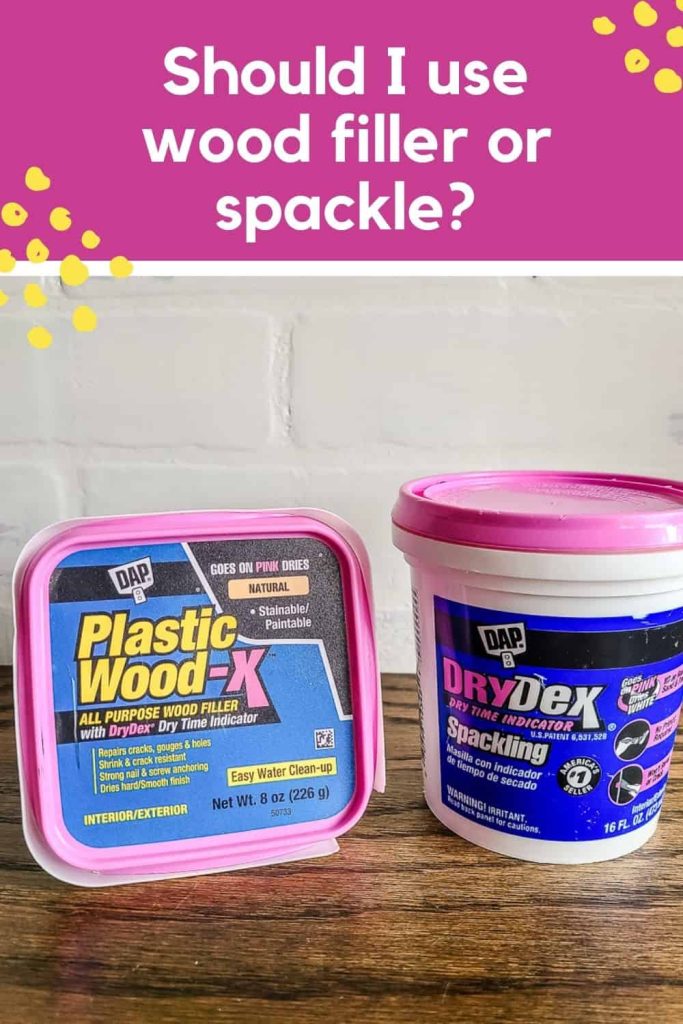
What's the departure between spackle and wood filler?
The difference between spackle and wood filler may be hard to tell because they both fill up holes on flat surfaces before painting and they are both sandable.
But the key difference betwixt spackle and wood filler is that spackle is not stainable like wood filler is. So if you are planning to stain your project – forest filler is definitely the right pick.
Going further, wood filler and spackle are made a lot differently – fifty-fifty though they do some of the aforementioned things (similar fill holes).
Forest filler is designed to cling and stick to wood, whereas spackle is made to attach to drywall, rock, and plaster. This is one reason why y'all should stick to woods filler for woods and spackle for walls.
Can you utilise spackle as woods filler?
1 of the large questions you're probably wondering is "can y'all utilize spackle every bit wood filler?" The answer is technically yes, it will usually "do the chore". If you lot're in a pinch and that'southward all you have and you only need to fill one small pigsty – sure, become alee. Yet, woods filler is mostly the better option when you're working directly with raw wood.
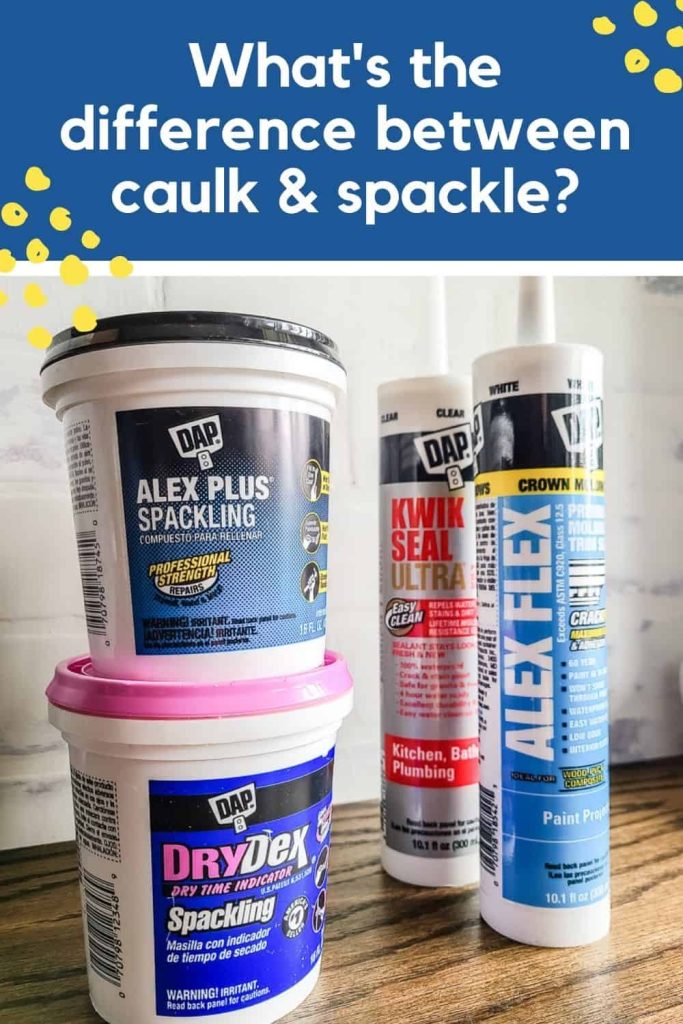
What's the deviation between spackle vs caulk?
To sum upward the deviation between spackle vs caulk, caulk is to be used to fill up in corners and gaps between two materials, whereas spackle should exist used to fill nail holes and other damage on flat surfaces (walls and/or trim).
Spackle tin can exist sanded and caulk cannot.
Joint Compound Overview
Joint Compound (besides called drywall mud or mud) is a moisture substance that is practical over the top of drywall to seal joints and create texture and a base for painting on interior walls and ceilings.
Joint compound is usually made with gypsum dust, water, and other ingredients. Sometimes it is sold as a dry powder that gets mixed with water and other products sell it as a pre-mixed material.
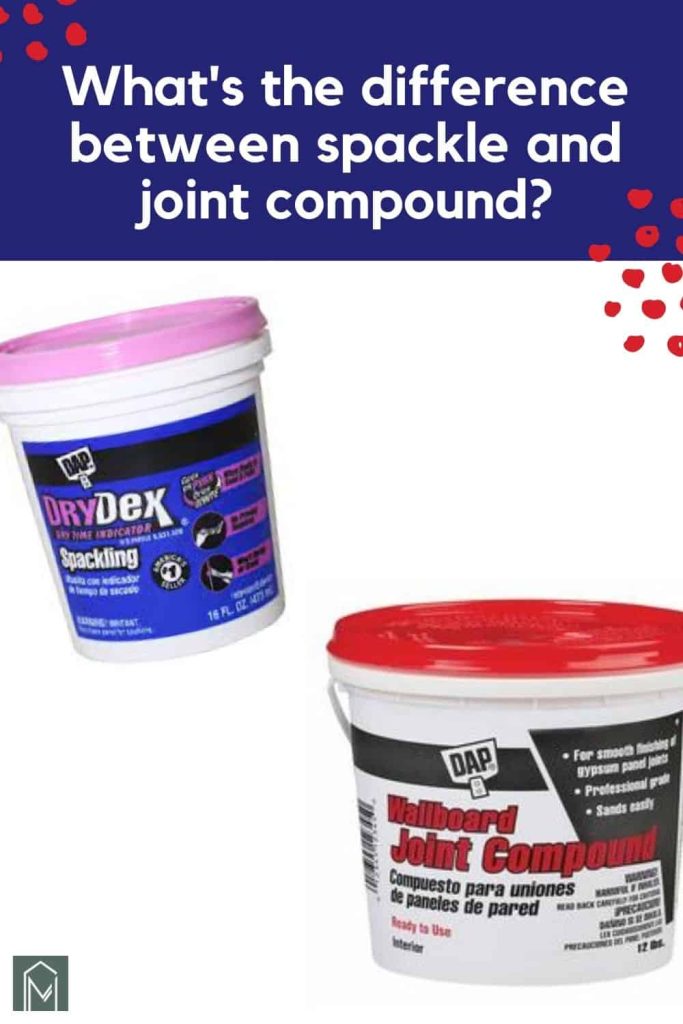
Is spackle the same as articulation compound?
Although spackle and articulation compound have similar jobs, they are very different. Joint compound is much runnier than spackle and, therefore, dries much slower than spackle (24 hours for joint compound vs one-5 hours for spackle).
Articulation compound should be used when texturing drywall or repairing big areas of damaged drywall. Spackle is best used for filling smaller holes and damage in drywall.
Articulation chemical compound definitely needs to be primed before painting, whereas many high-quality spackling products tin can be painted without priming offset.
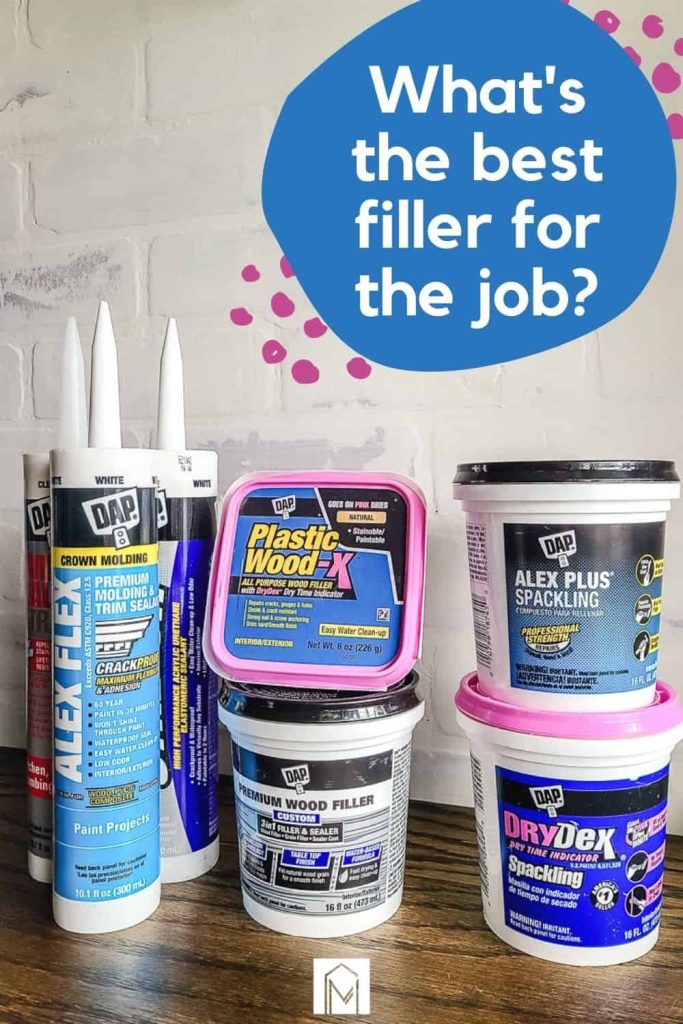
What's the best filler for the job?
Nosotros've covered a lot in this guide for filling holes and gaps, and then we thought we would sum it up with a list of basically everything task yous will find in renovations and DIY projects and end the debate on what product to use. No more wondering nearly spackle vs caulk or woods filler vs caulk!
Below you'll find a list of every product (caulk, wood filler, forest putty, and spackle) that we mentioned in the guide and a short bullet-indicate list of what to utilise the production on.
Alex Flex Caulk
- Filling gaps in trim (ie: board and batten walls)
- On the corners and edges of accent walls (ie: shiplap walls)
- Filling gaps between wall and baseboards
- Filling gaps between wall and door frame
- Filling gaps between wall and window frame
- Filling gaps between wall and moldings (ie: crown molding, pic rail, chair rail)
Kwik Seal Ultra Caulk (kitchen & bath)
- Filling gaps betwixt tile backsplash and countertop
- Sealing all joints and corners in a shower (When caulking in a shower, you want to add together it where the bathtub meets the tile wall, where the bathtub meets the tile flooring, all corners of the shower, forth the ceiling corner, and in all corners of the shower niche).
- Base of the bathtub where it meets the flooring
- Whatsoever edges of trim or walls that butt up confronting a shower or bath
- Filling gaps between sink and countertop
- Filling gaps between wall and countertop
Plastic Wood X Wood Filler
- Filling nail holes in woodworking projects
- Filling gaps betwixt two pieces of wood in a woodworking project
- Patching nail holes in woods trim and baseboards
- Filling gouges or imperfections in the wood
Premium Woods Filler
- Filling nail holes in woodworking projects (before staining or painting)
- Filling gaps between two pieces of woods in a woodworking projection
- Filling gouges or imperfections in the woods
- Filling grain on woods before painting
- Smoothing cracks in woods
- Shaping damaged areas, like corners and edges
- Interior or exterior apply
Plastic Wood Putty
- Filling nail holes, gouges, dents, and cracks on woodworking projects (after finishing)
- Repair damage to older wooden furniture or molding
- Interior use just
DryDex Spackle
- Filling nail holes on the wall before painting
- Smoothing dents and dings in walls before painting a room
- Filling dents, joints, and boom holes in pre-painted or pre-primed trim and baseboards before painting
- Filling boom holes and any imperfections on a door frame or window trim
- Patching boom holes on emphasis walls, similar board and batten and false shiplap
- Repairing a pocket-sized crack in drywall
Alex Flex Flexible Spackling
- Everything mentioned on DryDex Spackling (higher up)
- Repairing reoccurring cracks in drywall
Fast Dry Premium Spackling
- Everything mentioned on DryDex Spackling (above)
- When you're in a hurry and don't want to wait 1-v hours for the spackle to dry
Alex Plus Spackling
- Everything mentioned on DryDex Spackling (above)
There are so many different products out there for filling holes and gaps in your DIY project, it's easy to be confused. Hopefully, by using this guide, yous now know if y'all should use wood filler vs caulk or spackle vs caulk on your next project.
Yous tin can confidently head to the hardware store and buy your supplies knowing that you lot're buying the best filler material for your projection!
Do yous take any other questions about filling holes and gaps in your projects?
Let us know in the comments below!
Can You Use Spackle On Wood,
Source: https://www.makingmanzanita.com/caulk-wood-filler-or-spackle/
Posted by: nelsonbountly.blogspot.com


0 Response to "Can You Use Spackle On Wood"
Post a Comment